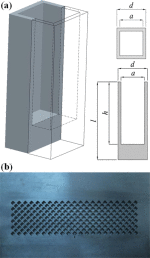Phononic crystals (PCs), which are composed of periodic scatters in an elastic host material, have attracted much research interest during the past few decades. Because of the anisotropic property and the Bragg scattering, PCs could be used to compose the flat lens to get acoustic focusing and imaging. Through coupling evanescent waves of the source to the surface modes or the guided modes or the Bloch modes in PCs, a subwavelength image beyond the diffraction limit could be achieved.
Besides bulk acoustic waves, focusing and subwavelength imaging for guided waves in elastic plate and surface waves on both the elastic solid surface and the liquid surface have been realized by introducing the periodic structures. In this research, it has been demonstrated that the subwavelength imaging can also be obtained through the surface acoustic waves (SAWs) on a two-dimensional (2D) structured rigid surface.
The SAWs discussed here are designated as spoof surface acoustic waves (SSAWs). Compared with the regular SAWs, the dispersion of SSAWs mainly depends on the geometrical parameters of the periodic structure rather than the material parameters. And the excitation and the detection of the SSAWs are convenient to accomplish in experiments for the energy totally locating in the air. So some properties of the regular SAWs can be obtained by investigating the SSAWs instead.
Recently, both the acoustic extraordinary transmission and the acoustic beaming effect have been realized through exciting the SSAWs on a textured rigid plate. By utilizing the periodic grooves with gradient depth, acoustic rainbow trapping is also realized. However, previous researches about SSAWs mainly focused on the 1D periodic structures. Here, the SSAWs are extended to 2D textured surface.
A square array of air boreholes is constructed in a perfectly rigid surface to compose a surface phononic crystal (SPC) and the dispersion property of the SSAWs for different sizes of the boreholes is also discussed. By utilizing the broad flat equifrequency contour of the SSAWs, subwavelength imaging has been achieved both numerically and experimentally. Because the dispersion property for SSAWs mainly depends on geometrical parameters of the structure and the convenient excitation and detection in experiments, it is believed that such acoustic devices based on SSAWs will bring great many potential applications in the design of acoustic imaging and focusing devices. A unit cell of the 2D SPC is schematically shown in Fig. 1(a), and the photograph of the sample used in the experiment is shown in Fig. 1 (b).

FIG. 1.
(a) Schematic illustration of the unit cell of the SPC. (b) Photograph of the sample used in the experiment (Image by ZENG).
This research was supported by the “Strategic Priority Research Program” of the Chinese Academy of Sciences (Grant No. XDA06020201) and the National Natural Science Foundation of China (Grant Nos. 11304351 and 11174316).
The research entitled “Subwavelength Imaging through Spoof Surface Acoustic Waves on a Two-dimensional Structured Rigid Surface” has been released in Appl. Phys. Lett. (103, 103505 (2013)). For more information, please link: http://dx.doi.org/10.1063/1.4820150.
Contact:
BAO Ming
Institute of Acoustics, Chinese Academy of Sciences, Beijing 100190, China
Email: baoming@mail.ioa.ac.cn


